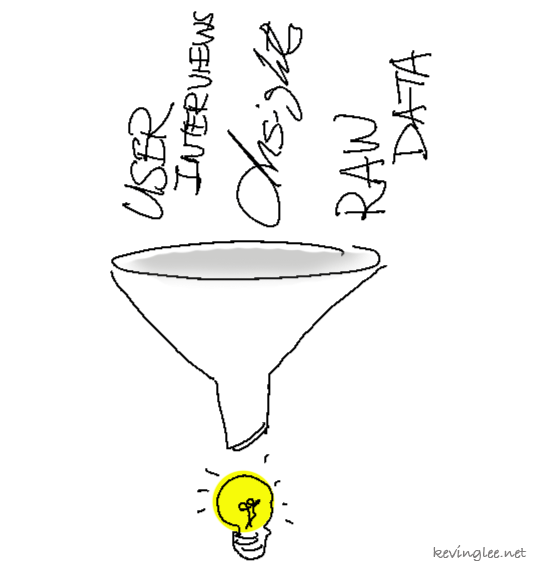
User research’s key step is modelling to synthesise the collected raw data. Kim Goodwin explains as it best below:
“A model is a description that helps people understand and communicate about observed behaviour. Bohr’s model of the atom and Freud’s ego, superego, and id, for example, gives us framework for understanding the complex ideas they stand for. Similarly, modelling the results of your research will help you condense and visualise information to understand human behaviour patterns, workflows, and trends.”
– Kim Goodwin
Modelling & artefacts generated are fundamental in contextualising the key insights discovered for the project team. Let’s review each key step.

Synthesise stakeholder findings
One of the first steps in starting a project is to map out who the stakeholders are, their influence/role, their stakes in the project, and a communication plan for engagement. Thereafter individual interviews to get informed on what the business goals & objectives are required, what the expectations are, as well as the parameters are also key to understanding. Typically the interviews should range with leaders from tech, business, customer service, etc.
In this phase, it’s best to reflect back on what you’ve heard to summarise what you’ve understood of their visions, concerns, and disagreements. If there are gaps or controversies, you should be able to address them with your fact-finding studies— as key questions you’d aim to answer via research. As the UX lead, it’s essential that members of your team have a shared understanding of the political landscape and potential barriers to success such as tech/business constraints ahead of time.
Begin analysing user data and drafting findings
Get started with qualitative analysis is it’s ideal for explaining Why and How, as well as What. If time & resources allows, ethnographic research with target Users of 35+ participants to have access to a broad enough view across as well as being able to go deep. Contextual design or inquiry advocated by Karen Holtzblatt is regarded highly in the industry to undertake comprehensive ethnographic research on the field to arrive to having genuine empathy with Users. The science of obtaining un-biased user & customer data, combing through them to visualise patterns of behaviour can be outlined as per below:
- Getting started with qualitative analysis is it’s ideal for explaining Why and How, as well as What. If time & resources allow, ethnographic research with target Users of 27+ participants to have access to a broad enough view across as well as being able to go deep. Contextual inquiry advocated by Karen Holtzblatt is regarded highly in the industry to undertake comprehensive ethnographic research on the field to arrive at having genuine empathy with Users. The science of obtaining unbiased user & customer data, and combing through them to visualise patterns of behaviour can be outlined below:
- Undertake single-case analysis via interviews & observations
- Condense & organise data: cross-case analysis which involves grouping & comparing individual cases to identify trends & behaviour patterns. is an excellent technique to do in a workshop
- Interpret (find & explain patterns) – unboxing insights as a group (researchers from the field) leads to efficient inductive reasoning. Best to do this soon after the field research while the details are fresh in people’s minds
- Validate – if any inferences are made & inductive reasoning needs further validation, best to undertake them by following up with research participants. Diary studies are also useful to supplement further data to gain Users’ perspectives
- Communicate – share the insights with stakeholders as well as the team assigned to the project, making sure that they are easily consumable & backed up with evidence.
Create personas
User personas based on research & facts are key examples of UX artefacts which can be shared with project members. It is visual & impactful in getting the fundamental insights and will serve as a ‘compass’ for the whole project team in making design decisions moving forward. Some orgs go as far as creating User persona rooms which are filled with persona artefacts where anyone can walk into it and experience the information in an immersive environment. To read more on personas and approach them in a Lean UX method, read this post.
Finalise user findings and other models
Here the UX team needs to filter and focus on the key insights to share with stakeholders as time is limited for both parties. Key mental models of Users, Persona boards, context scenarios with case studies, and visual patterns of trends are essential when communicating the results. As good practice, having supporting resource materials of factors which influenced the results can be auxiliary data which can be sourced optionally for them.
Wrapping up
These days UX designers are part-time researchers as well as full-time UX evangelists by default. And that comes with consistently applying the methods which are evidence-based and promoting the insights gained — and validating the time spent on research. Quantitative data are indeed valuable while it is limited to fully understanding the complexities of human behaviour if applied itself only. Qualitative analysis based on solid ethnographic research, coupled with quantitative analysis (as mixed-method research) is proven to be the most effective.
Recommended reading: Kim Goodwin‘s excellent book “Designing for the Digital Age”


